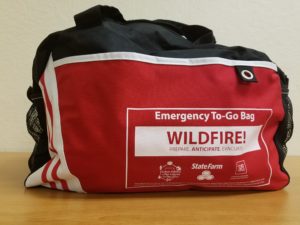Prepare for Wildfire - Pack a To-Go Bag
July 26th, 2018

- Photograph Courtesy of University of Nevada Cooperative Extension
My colleague shared her experience when a wildfire was approaching her community several years ago.
“In the early morning hours, I woke to a nearby friend’s text saying ‘I can see the flames coming down the hillside. We’re evacuating!’ After racing out the front door, smelling smoke and seeing the hillside pulsing a vivid red, I did what any well-prepared person would do – I panicked! Through my frightened tears, I started searching for a long lost ring I had promised to give my son, grabbed photo albums and framed portraits off the wall, and dug through the desk for important papers. I was not prepared and my panic made it hard to think rationally.” Evacuating your home during a wildfire is a terrifying experience. It’s difficult to think accurately and quickly when faced with the imminent threat of wildfire. With all of the wildfires occurring in the summer and inquiries about packing to-go bags, I thought it might be useful for residents to view a detailed list of what to pack. The following is a checklist of items that individuals should consider packing in their to-go bag. It’s recommended that residents should pack one for each family member, and one for each of their pets. It’s important to note that to-go bags should be prepared BEFORE a wildfire threat begins.
- Water – One gallon/person/day (3 day supply for evacuation).
- Food – non-perishable (3 day supply for evacuation).
- Flashlight.
- Battery powered or hand crank radio tuned to a local news channel.
- Extra batteries.
- First aid kit.
- Medications (7 day supply).
- Multi-purpose tool.
- Sanitation and personal hygiene items (shampoo, conditioner, soap, toothbrush, toothpaste, etc.).
- Copies of important documents in your to-go bag and stored away from the home (medication list, medical info, proof of address, deed/lease to the home, bank, IRS, trust, investments, passports, birth certificates, insurance policies, etc.)
- Computer back up files, posted on the cloud or saved on a thumb drive.
- Inventory of home contents. Consider making a list, utilizing a home-inventory app, or videotaping prior to an emergency. Store them on the cloud or keep them in a safe place away from your home.
- Photographs of the exterior of the house and landscape.
- Cell phone and charger.
- Family and emergency contact information.
- Extra cash, Credit/ATM Debit cards.
- Emergency blanket.
- Clothing for 3-5 days.
- Family heirlooms, photo albums and videos.
- Maps of the area.
- Medical supplies (hearing aids, with extra batteries, glasses, contact lenses, syringes, cane, etc.)
- Baby supplies (bottles, formula, baby food, wipes, diapers, etc.)
- Games and activities for children.
- Pet supplies (collar, leash, ID, food, carrier, bowl, etc.)
- Ensure you have a picture of your animal in case they are lost during a wildfire.
- Two-way radios.
- Extra sets of car keys and house keys.
- Manual can opener.
This checklist was adapted from to-go bag lists on www.Redcross.org and www.livingwithfire.info

Jamie Roice-Gomes is the manager and outreach coordinator with University of Nevada Cooperative Extension’s Living with Fire Program. She earned her Bachelor of Science in Wildlife Ecology and Conservation and a Master of Arts in Interactive Environmental Journalism. She was a public relations assistant for Conrad Communications, a public information officer intern at the Nevada Department of Conservation & Natural Resources, and a Biological Science Technician at the USDA-Agriculture Research Service. She also enjoys volleyball, the Great Basin Desert, and spending time with family. Contact Jamie at 775-336-0261 or roicej@unce.unr.edu.
